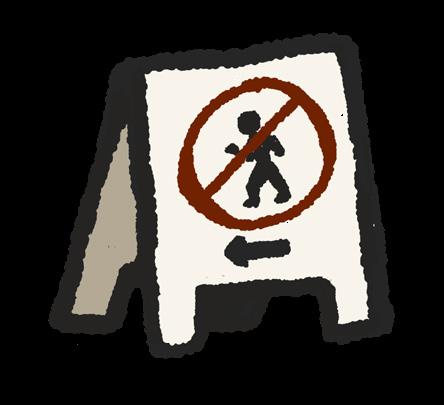





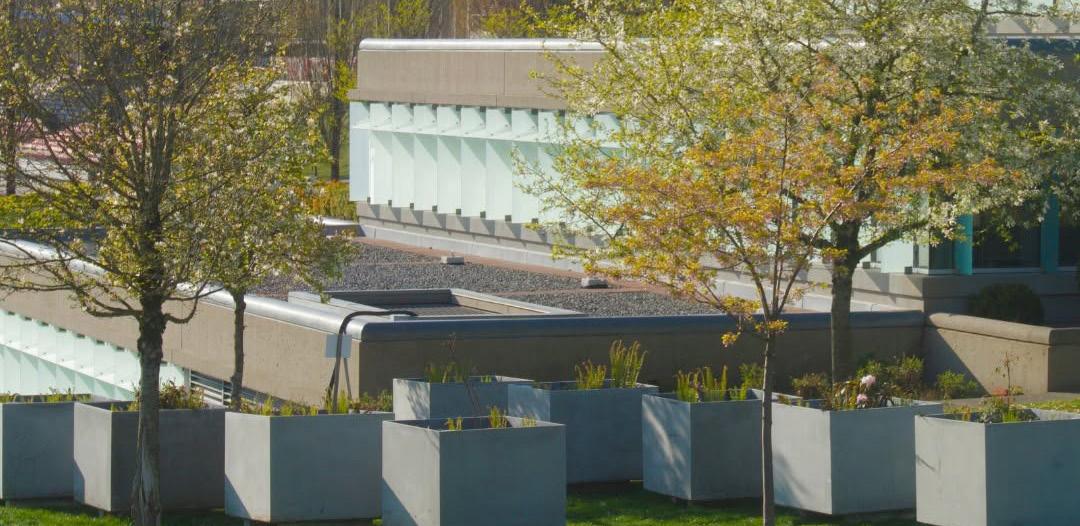




EDITORS-IN-CHIEF
C Icart and Michelle Young eic@the-peak.ca
COPY EDITOR
Michelle Young copy@the-peak.ca
FACT CHECKER
Karly Burns factchecker@the-peak.ca
NEWS EDITOR
Hannah Fraser news@the-peak.ca
NEWS WRITERS
Corbett Gildersleve and Lucaiah Smith-Miodownik
OPINIONS EDITOR
Petra Chase opinions@the-peak.ca
FEATURES EDITOR
Daniel Salcedo Rubio features@the-peak.ca
ARTS & CULTURE EDITOR
Phone Min Thant arts@the-peak.ca
HUMOUR EDITOR Mason Mattu humour@the-peak.ca
STAFF WRITERS
Zainab Salam, Ashima Shukla, and Yildiz Subuk
BUSINESS MANAGER
Yuri Zhou business@the-peak.ca (778) 782-3598
PROMOTIONS MANAGER
Juliana Manalo promotions@the-peak.ca
PROMOTIONS AND SOCIAL
MEDIA ASSISTANT
Jenna Emperador
PRODUCTION & DESIGN EDITOR
Abbey Perley production@the-peak.ca
ASSISTANT PRODUCTION EDITORS
Mary Gigiberia and Minh Duc Ngo
PHOTO EDITOR
Gudrun Wai-Gunnarsson photos@the-peak.ca
WEB MANAGER
Subaig Bindra web@the-peak.ca
BOARD OF DIRECTORS
Rebecca Dersey, Liam McKay-Argyriou, Yildiz Subuk, Olive Visser, and Yuri Zhou
CONTRIBUTORS
Noah Jozic, Manal Kashif, Emily Le, Audrey Safikhani, and Kyla Wane
PEAK ASSOCIATES
Cliff Ebora, Sarah Sorochuk, Abigail Streifel, and Angelina Tran
COVER ARTWORK
Bithi Sutradhar
The Peak MBC2900 8888 University Dr. Burnaby, BC V5a 1S6


Follow us on Instagram, at @thepeakatsfu and check out our YouTube channel, The Peak (SFU).
READ THE PEAK
Pick up paper copies at any SFU campus Find extended, cited, and web-accessible articles at the-peak.ca Download digital issues at issuu.com/peaksfu
The Peak is SFU's weekly student newspaper published every Monday, by students, for students. We’re funded by a student levy and governed by a Board of Directors. Any SFU student can apply to become staff.
We reserve the right to edit submissions for length, as well as style, grammar, and legality. We also reserve the right to reprint submissions at any time, both in print and on web. We will not publish content that is sexist, racist, or otherwise prejudiced.
(TsleilWaututh),
support organization highlights colonial child welfare practices

At the end of last year, the BC Ministry of Children and Family Development reported 4,843 children and youth “in care.” These are children 19 and younger whose “custody is with the ministry or with a Delegated Aboriginal Agency.” Of this number, about 68% of youth were Indigenous. According to their website, the ministry’s focus is to aid BC youth in relationships with their families, communities, and culture. As a part of this mission, they support various programs and services designed to help those with current or past experience in the foster care system. Foster care looks after those “who must be away from their own families.”
The ministry also supports former foster care youth over 19. One initiative designed to do so is Strengthening Abilities and Journeys of Empowerment (SAJE), for ages 19–26, which lists benefits like “planning for [the] future, income and housing supports, mental health benefits, and training and cultural connections.” More specifically, SAJE states it can provide rent supplements to support youth formerly in foster care with up to $600 per month for up to two years. The program claims that “50% of the rent supplements are first available to Indigenous young adults.”
However, these supplements have recently fallen under scrutiny. IndigiNews reported in late March that they have not been distributed in over a year. The Peak corresponded with the ministry and the Indigenous Child & Family Services Directors Our Children Our Way Society (OCOW) to learn more. OCOW represents 25 Indigenous Child and Family Service Agencies and focuses on “self-government pertaining to the well-being of [Indigenous] children and youth.”
“Youth aging out of government care have had to deal with higher rates of homelessness and mental health concerns,”
minister of children and family development Jodie Wickens said. “SAJE offers services like income support of up to $1,250 a month” to cover living expenses, she added. This is separate from the rent supplement program.
Since the very first contact between settlers and Indigenous Peoples, paternalistic colonial child welfare practices have had destructive impacts on the well-being of our children and families.
INDIGENOUS CHILD AND FAMILY SERVICES DIRECTORS OUR CHILDREN OUR WAY SOCIETY
As reported by IndigiNews, an individual under the pseudonym Jamal has made three unsuccessful rent supplement applications since February 2024 and highlighted that $1,250 in income support would “barely cover” his rent.
While The Peak asked for confirmation on this lack of payment, Wickens did not address the question. “Over 1,800 young adults from care received rent supplements since
the introduction of the program in fall 2022,” she said. If demand for the supplements exceeds funding, SAJE “would work closely with frontline staff and our colleagues in other ministries to explore alternatives so that the greatest number of young people are covered.”
OCOW also emphasizes that these welfare systems are essential to Indigenous self-determination, yet the government has failed to adequately support them, particularly in ways that are culturally grounded. “Since the very first contact between settlers and Indigenous Peoples,” the organization’s site reads, “paternalistic colonial child welfare practices have had destructive impacts on the well-being of our children and families.” OCOW added, “It’s time for that to change.” The Indian Act, “first proclaimed in 1876, gave the federal government control over most aspects of Indigenous people’s lives,” OCOW writes. “In 1951, the federal government amended the Indian Act to include Section 88, which gave provinces the power to enforce their child welfare laws on-reserve.”
Tracy Lavin, OCOW manager of policy, research, and engagement presented some potential insight into SAJE’s struggles. For services off-reserve, she explained that Indigenous Child and Family Service Agencies are funded through the ministry. “The ministry is not bound by the Canadian Human Rights Tribunal rulings noted above. Those services are desperately underfunded and do not support the delivery of prevention/least disruptive measures,” said Lavin. Regarding SAJE specifically, “OCOW has repeatedly articulated numerous concerns about the SAJE program raised by the Indigenous Child and Family Service Agencies,” however, there has been “very little response from the ministry.”
This is a response to an action report from the Post-Secondary Overdose Prevention and Response Steering Committee
CORBETT GILDERSLEVE · NEWS WRITER
On March 11, SFU announced that naloxone kit cabinets are now available across the Burnaby, Surrey, and Vancouver campuses. Naloxone is a medication that works within two minutes to “temporarily reverse the effects of an opioid overdose, also called an opioid poisoning.” These cabinets have been installed near emergency phones and/ or Automatic External Defibrillator locations, including instructions on how to use naloxone. Maps of these locations are available on the SFU Safety & Risk Services website and SFU Safe app via the “First Aid” tab. The Peak reached out to Sarah McKay, director of Campus Public Safety (CPS), and was forwarded to the Office of Student Support, Rights & Responsibilities for more information, but did not receive a response by the publication deadline.
The provincial government required the installation of naloxone kits as part of an early action report from their Post-Secondary Overdose Prevention and Response Steering Committee. This committee was formed in late May 2024 by the minister of post-secondary education and future skills, Lisa Beare. The committee was tasked with “developing overdose prevention and response actions for public post-secondary schools” for the fall 2024 term. These actions included prioritizing calling 911 first over campus security when there’s a medical emergency and having post-secondary institutions sign up for toxic drug awareness services like Toward the Heart.
BIG MOVE FOR EMBARK
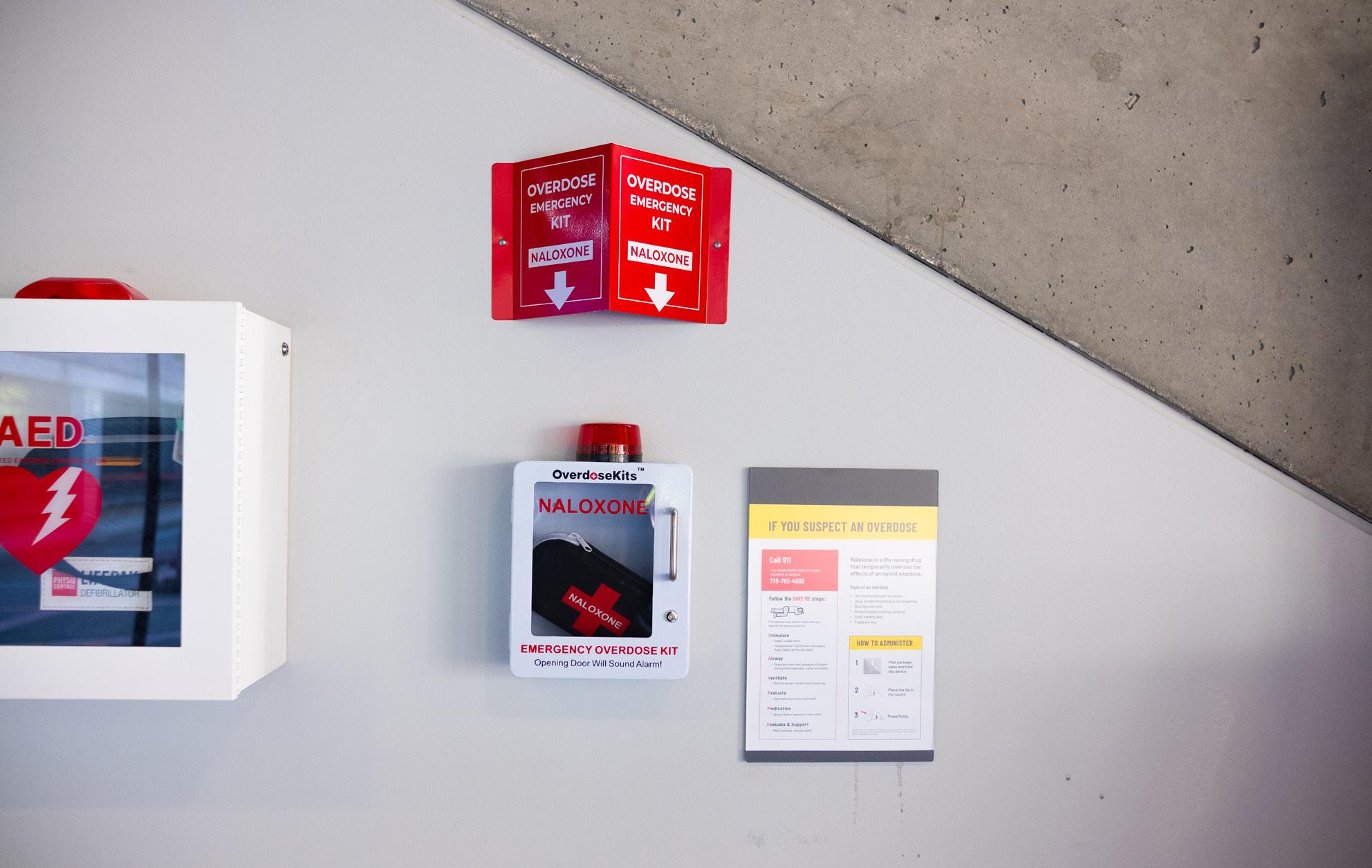
Maps of these locations are available on the SFU Safety & Risk Services website and SFU Safe app via the “First Aid” tab.
It was also recommended that access to naloxone be improved in student housing and on campus in conjunction with awareness of overdose prevention. The committee developed a 10-page guide for post-secondary institutions which built on the early action recommendations with additional actions. Notably, these guidelines recommend working closely with First Nations “to develop overdose response plans.” This involves recognizing them as “another level of government” and following through with “Declaration on the Rights of Indigenous Peoples Act, the Truth and Reconciliation Commission Calls to Action, and the broader commitments of the province to First Nations.” The guidelines also include considerations toward additional training around “cultural safety and anti-Indigenous racism practices.”
The garden has 10 garden plots, with 20 more to be added
CORBETT GILDERSLEVE · NEWS WRITER
HANNAH FRASER · NEWS EDITOR
Embark Sustainability’s community Burnaby Learning Garden is moving from outside the Technology and Science Complex (TASC) 1 to the field behind the Maggie Benston Center (MBC). They will transition over the next few years as they break down the current wood plots at TASC 1, buy longer-lasting aluminum plots, and move the soil. The Peak spoke with Marie Haddad, director of engagement, and Pablo Vimos, gardens manager, to learn more about the move and Embark’s gardening cohort program.
In 2023, Embark celebrated the garden’s 10th anniversary. “All the garden beds are made of wood with a long life of 5–6 years, pushing. But we’ll be extending it by repairing/ rebuilding the garden beds,” Vimos said. He noted that lumber became expensive due to COVID-19, making the old beds “not sustainable to keep repairing.” After discussing the gardens with SFU Facilities, they decided to move to permanent garden beds — such as the aluminum ones for their separate Student Union Building Learning Garden — as they would last longer. While rebuilding the wooden beds every three years costs about $950 in materials and labour costs, Vimos noted the aluminum beds cost $1,800 with a “lifespan of over 20 years.”
Vimos explained that the original garden at TASC 1 has 60 garden beds, but Embark will not move all of them, given that the aluminum garden beds are still expensive. The not-for-profit will shrink the number of beds down to 30, with Haddad noting that 10 beds have already been moved to MBC. Embark is waiting on 20 more aluminum beds to transition the rest of the old beds. When asked how long they will be in the MBC field, Vimos said, “with Facilities, we
have a three-year lease agreement,” with the lease having to be renewed.
The garden cohort programs or any of our other programs are never only for students who are learning about environmental science majors or climate majors; they’re really for anyone.
MARIE HADDAD
DIRECTOR OF ENGAGEMENT, EMBARK SUSTAINABILITY
Embark uses the garden plots to run their learning garden programs. Last year, the program had 25 garden graduates, training up to 12 students per semester. The garden cohort meets once a week for 1.5 hours, with the first 30 minutes having a “teaching element” and the remaining hour being for hands-on experience, according to Vimos. Haddad added that “students learn this practice of sharing. You grow your food, you share it with your own family, you share it with your friends, your cohort members, and then a lot of the harvest also goes to the Food Rescue Program.” This program rescues healthy food that doesn’t meet store criteria for sale, thus distributing the food to students at SFU. Last year, 945 kg of food was rescued from
SFU stated in its announcement that many of these recommendations were already being followed before the report was released, with the university now making improvements. In 2021, CPS added “naloxone training to their basic first aid courses taught to students, faculty, and staff.” Additionally, “all CPS staff have mandatory Occupational First Aid 1, 2, or 3 training, Mental Health First Aid Canada, and SafeTalk suicide intervention, prevention and response certifications.”
The Peak reached out to SFU for a statement on their engagement with the Indigenous-related recommendations: “The university has worked to include Indigenous leaders and staff at the SFU Indigenous Student Centre in training and harm-reduction education sessions.” They also noted they are “in communication with the First Nations Health Authority to support integration of their Not Just Naloxone train-the-trainer program to support further development of SFU community member-led training and education. This work is still ongoing and will be integrated into planning for new student orientation, as well as more training and workshop offerings this fall.”
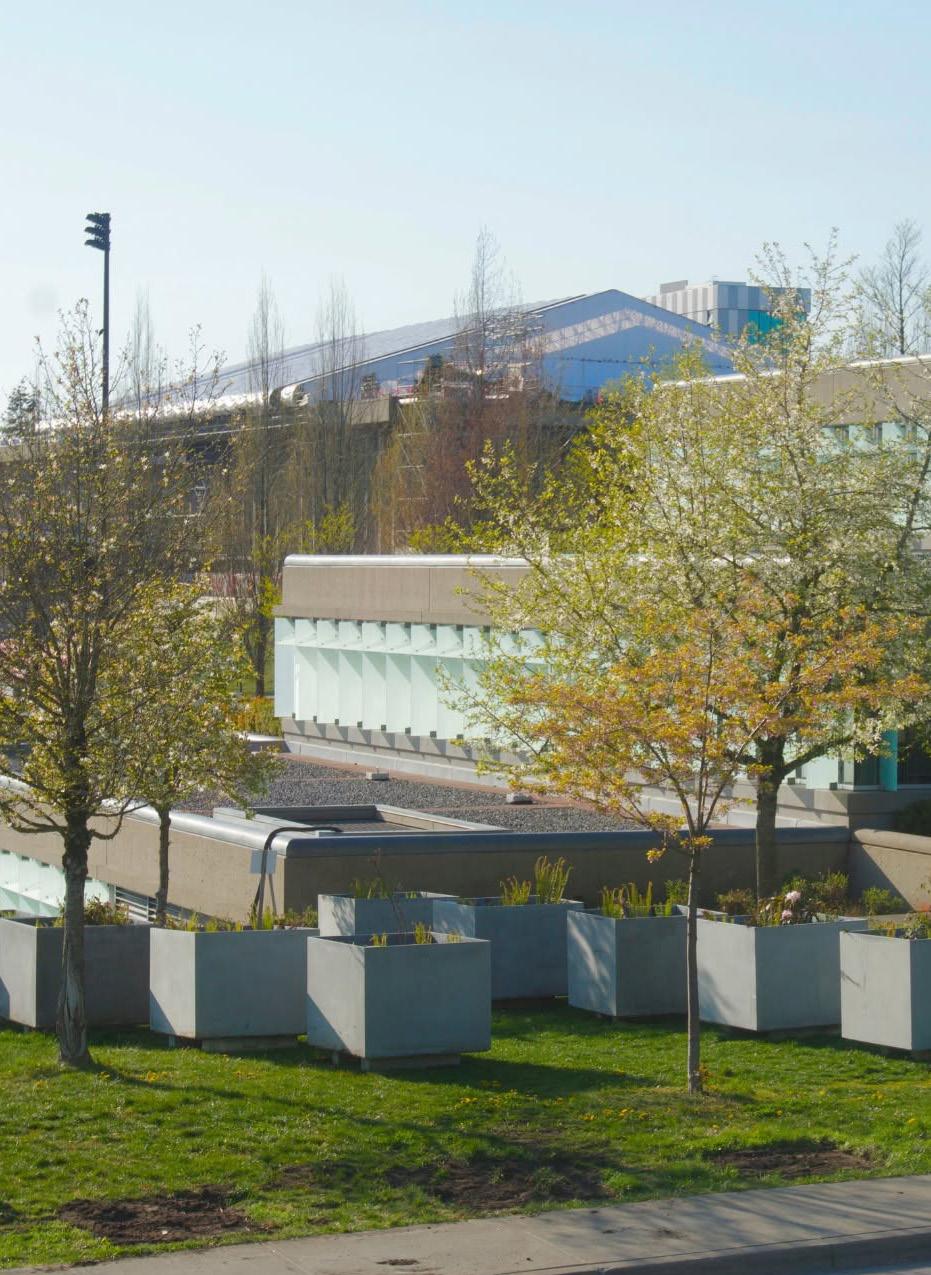
When asked what’s next for the Burnaby Learning Garden program, Vimos said, considering student interest was low for the summer cohort, Embark will be changing the cohort into a gardening stewardship where teaching is more informal. He explained that the gardening stewardship will happen at students’ available time: “They can come anytime, any day of the week [ . . . ] as long as the garden is being maintained.” Haddad added that while students learn from Pablo, “there’s also some new members who are going to help out,” allowing for a “students-teaching-students moment.”
Haddad added, “The garden cohort programs or any of our other programs are never only for students who are learning about environmental science majors or climate majors; they’re really for anyone.”
Climate realism is a luxury, but radical hope is our political imperative
ASHIMA SHUKLA · STAFF WRITER
In a recent article for the American think tank Council on Foreign Relations, senior fellow for energy and climate Varun Sivaram proposed a new doctrine for climate policy: climate realism. This seemingly pragmatic approach argues it’s impossible to avert climate change completely. Instead, it claims the US should favour more profitable and geopolitically strategic ways of managing climate consequences.
In truth, climate realism is anything but realistic. This elitist discourse cloaks inaction, securitization, and racialized control. For example, Sivaram weaves a story of how carbon emissions from “emerging and non-advanced economies” are threatening the survival of American society to justify penalizing countries in the Global South that use fossil fuels. Behind this facade lies an unsettling truth: climate realism is a luxury afforded only to those distant from disaster. For Indigenous communities around the world, this “climate apocalypse” is a long-lived reality. For many of us, the dystopia is now.
But even on capitalism’s own terms, climate inaction is a losing game. In 2022 alone, climate-related disasters cost the global economy over $430 billion CAD in economic losses. Rising sea levels could add another $550–715 billion CAD per year by 2100, along with 250,000 more lives lost annually from 2030 to 2050.
SUFFICIENCY IN SELF-CHECKOUT

Yet, what this so-called realism sidelines holds our greatest hope: Indigenous communities across the world embody models of climate resilience based on reciprocity, relationality, and collective care. The Anishinaabe, for instance, find resilience in their heritage of fluid governance systems. These systems shift with seasons, mirror the dynamic rhythm of their ecosystems, and exist in conversation with the land, ancestors, and descendants.
For Indigenous communities around the world, this “climate apocalypse” is a long-lived reality. For many of us, the dystopia is now.
The Menominee tradition similarly shifts our idea of space and identity, breaking down the human/non-human binary. When elder maple trees become our guardians, the forest is no longer a resource to be exploited. Confronted with settler colonialism, the Menominee ancestors chose kinship with
Buying groceries shouldn’t be an isolating experience
MANAL KASHIF · SFU STUDENT
People use self-checkout during their grocery hauls for various reasons, including saving time. Self-checkouts became popular around a decade ago to promote efficiency in the checkout process. However, it’s now being brought to light that this costcutting method fails to lead to better experiences for customers, especially when it’s the only option available.
Many Canadians prefer regular checkouts over self-checkout because of the ease of having someone else scan their groceries. Engaging in friendly conversation can also be a highlight during a busy day of errands.
Many self-checkouts also aren’t suited for blind or visually impaired shoppers, as they don’t have audio guidance, according to Canadian Affairs. A study in the Journal of Business Research found the rise of self-checkout “shifts the work to customers, [making] them feel less rewarded,” and eventually, less likely to visit stores with more self-checkouts.
Trying to make the grocery shopping experience “selfsufficient” is not only bad for business, but also isolating. The type of conversations people have with their cashiers are known as “low-stakes interactions.” While they might seem insignificant in the moment, University of Michigan professor Toni Antonucci claims they’re “a critical tool for maintaining emotional well-being later in life as social circles shrink.”
In a world where online shopping has quickly taken over, implementing machines like self-checkouts in public places is
the nail in the coffin. By walking away from regular checkout, we are further falling into the hole of less communication and more individual experiences, contributing to a rise in isolation.
A small conversation in the rush of everyday life or even a smile can go a long way.
A study showed that those aged 18 to 34 prefer self-checkout over cashier interaction, but the opposite is true for folks aged 55 or older. The appeal seems to decline as there’s an increase in age groups. Still, that does not mean self-checkout is the future, as many stores have started ditching self-checkout options due to technical issues, customer feedback, and theft.
As someone who almost always uses a regular checkout, I find the interaction between the cashiers and I to be part of what makes us all functioning members of a society. A small conversation in the rush of everyday life or even a smile can
the non-human, imagining sustainable harvesting practices that ensured the land’s long-term health. In doing so, they transformed the forest into a space of mutual learning, where Indigenous knowledge can be practiced alongside ecological science. The forest, then, is not only a source of economic sustenance but also a living, breathing archive of Menominee cultural endurance and wisdom.
These are not just peripheral climate strategies but living embodiments of the 4Rs at the heart of many Indigenous knowledge systems: respect for all beings; relevance rooted in lived, localized experience; reciprocity as a fundamental ethic; and responsibility to care for what we inherit and leave behind. Climate realism, by contrast, is top-down, neocolonial, and ultimately nihilistic. And while despair, exhaustion, and grief are valid responses to a world built on organized greed, activist and prison abolitionist Mariame Kaba reminds us that “hope is a discipline.” It is a daily practice, a refusal to surrender, and a commitment to imagine otherwise. It is organizing, remembering, dreaming.
Environmental professor Robin Wall Kimmerer, in her book Braiding Sweetgrass, explains that reciprocity is not a metaphor — it is a political imperative. We find ourselves in a profound contradiction where decay and delusion coexist with radical potential. We face stagnation and suffocation. And we also face a moment of rebirth: of resistance, of relational thinking, of decolonial worldmaking. The question isn’t whether alternatives exist, because they do. The question is whether we have the courage to learn from and live with them, for the world pulsing beneath our feet.

GenAI might be advertised as convenient, but it cannot replace you
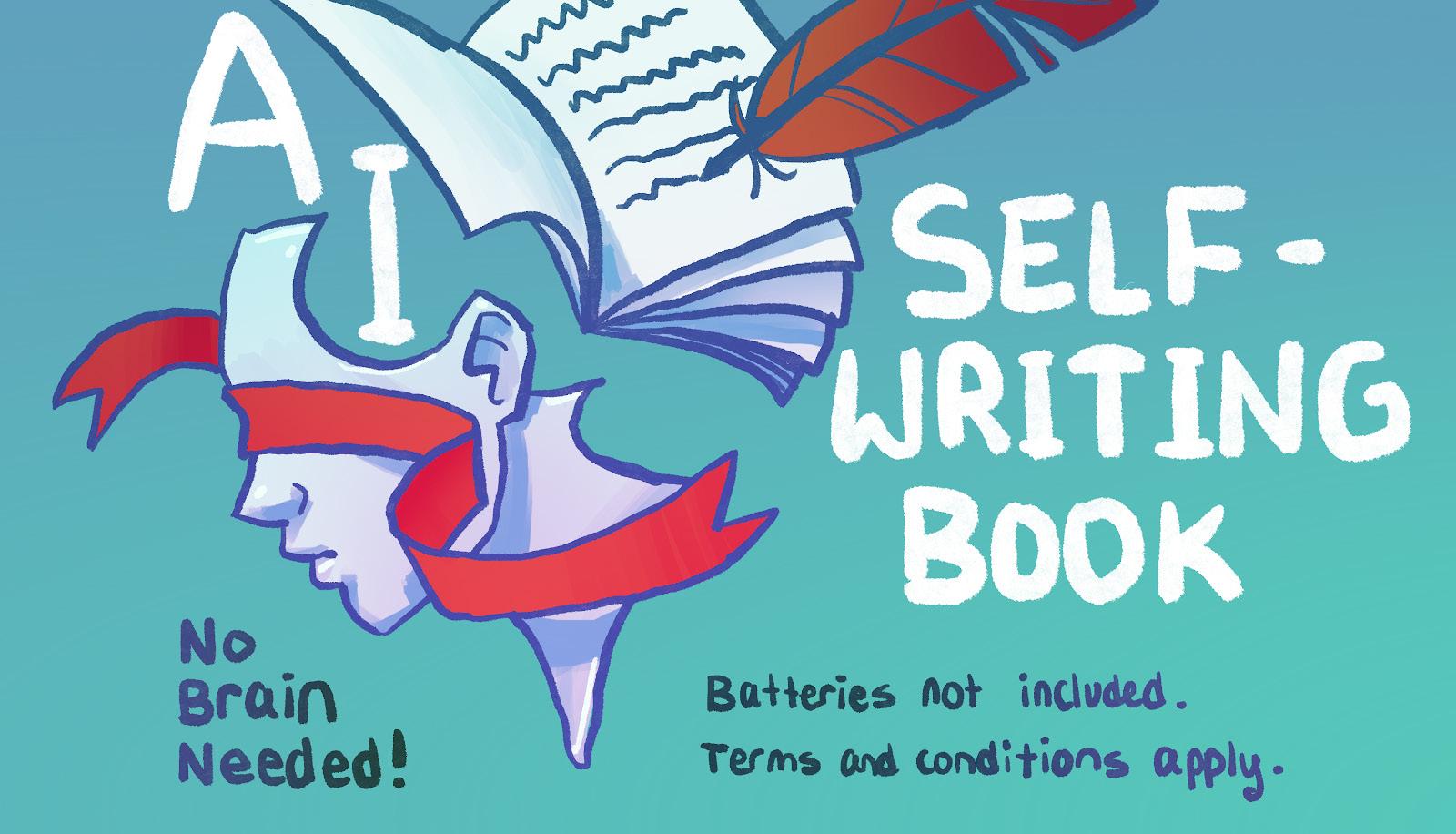
When I began my university career, the concept of generative artificial intelligence (GenAI) felt like a futuristic thing that someone like me, who doesn’t like using technology much, wouldn’t have to deal with for decades. In the past year or so, there was a shift in how the syllabus began to be presented to us. Suddenly, professors were warning us against plagiarism through AI use. Some universities even began to enforce strict GenAI rules. At SFU, the policies surrounding the use of GenAI are at the instructor’s discretion. Ironically, I wouldn’t have even considered that GenAI tools could be used for educational purposes if it weren’t for the unintentional marketing through professors — mostly through banning us from using it.
That being said, we are running into a dilemma. With the increase in AI combatting regulations, we are seeing an increase in the complexity of assignments. Ironically, that increase in complexity is assisted by AI software and encouraged by higher education institutions. Considering that students need to remain in good academic standing, the worth of the grade is estimated at a higher value than the benefit of learning. For the average student, an important question arises: do I work more hours to provide for myself, or do I spend more time studying when the benefits are in the future? The answer to this question is quite simple: when there is an option to help attain higher grades while keeping a roof over your head, you are more likely to take it. It quickly becomes apparent that the overall benefit for our minds takes a backseat to the need of the moment.
Online, it’s been another deal altogether. GenAI and its array of writing tools are often marketed to streamline the writing process. However, with time, it’s become clear that reality is more complex. At its core, writing is both an art and a form of communication, a human process rooted in individuality. Relying on GenAI to write is not just a shortcut; it’s a compromise of authenticity and meaning.
A glaring flaw in AI-generated writing is its illusion of objectivity. While GenAI systems are programmed to produce text that appears neutral or unbiased, this is misleading. The data that GenAI pulls from is riddled with bias stemming from the bias of its sources. So, the outputs may inadvertently reflect
stereotypes, outdated perspectives, or cultural insensitivity. For instance, GenAI translation tools may struggle with nonwestern languages that have complex grammatical structures or idiomatic expressions, resulting in oversimplifications or misrepresentations. This not only can be offensive, but also contributes to cultural homogenization by prioritizing dominant cultural values over those of minority cultures.
On the other hand, human writing can embrace both objectivity and subjectivity, depending on our writing needs. Our words are shaped by personal experiences, cultural backgrounds, and diverse ways of thinking. This makes every piece of human writing unique. In contrast, AI-generated text often comes across as generic or hollow because it universalizes inherently personal and varied concepts.
useful for simple prompts or checking grammar, it cannot substitute for the creative and personal process that human writing entails. Writing is a skill that requires consistent practice to develop. Using GenAI to complete writing tasks robs individuals of the opportunity to refine their voice and storytelling ability. If the words aren’t coming from you, are you saying anything at all?
As of late, GenAI has been converging with our lives. Even credible sources are promoting its use in professional settings in the name of enhancing productivity. However, should productivity be the end goal for all our professional endeavours? Should I aspire to work in a company if GenAI can be and is preferred over me? This sentiment does not extend to cases where GenAI can decrease the level of danger that workers face in physical labour jobs. In that case, the wellbeing of the person is of the utmost importance.
Ultimately, writing is more than just stringing words together; it’s about conveying one’s unique perspective and crafting a message that only a human mind can fully conceive. GenAI cannot encapsulate the creative force or personal depth that comes from writing with intention and heart.
One of the fundamental issues with AI-generated text is that it lacks the personal touch essential to genuine writing. Programs like ChatGPT don’t create from experience. Instead, they generate content by analyzing patterns in vast datasets, essentially reforming existing information. While this may be
As a species, we are not the strongest, fastest, or most adaptable in the physical sense. However, we are intellectual. Our communication skills are what make us stand apart from the rest of the living creatures. Language is one type of communication that humans can use. Words are one of our superpowers. Writing has enabled us to articulate ideas, preserve knowledge, and inspire change throughout history. Writing is not just a skill; it’s the expression of our shared humanity. This superpower is as strong as its wielder. When we rely on GenAI to write for us, we are not merely outsourcing a task, we are diluting our ability.
In reality, GenAI falls short when it comes to creating meaningful work. The power of storytelling, which in many ways is relevant even in academic texts, lies in its ability to connect and resonate on an insightful level. Writing is an extension of the writer; their ideas, feelings, and influences are transcribed through their words. Ultimately, writing is more than just stringing words together; it’s about conveying one’s unique perspective and crafting a message that only a human mind can fully conceive. GenAI cannot encapsulate the creative force or personal depth that comes from writing with intention and heart. When it comes to telling your story, the best voice will always be your own.
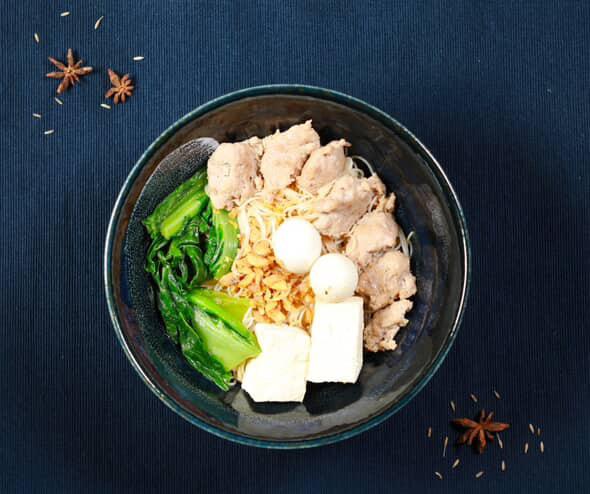



Content warning: brief mention of genocide.
In Burma, April is a time for celebrating a new year. During the five-day festival called Thingyan, people pour and throw water on each other on every street, a symbolic cleansing of past sins. Padauk, the national flower, blooms under the summer sun, framing faces and illuminating scenes with golden yellow.
This year, however, Burmese people came together to respond to a devastating 7.7 magnitude earthquake that struck on March 28. Over 4,000 people have been reported dead, almost 4,800 injured, and 129 missing. These numbers are likely a lot larger.
A natural disaster is tragic enough. Under a corrupt and genocidal military dictatorship, it’s even more horrifying. The military has continued to attack ethnic minorities by keeping on its airstrikes on unarmed settlements. When it comes to rescue efforts, civilians are mostly left to their own devices. Since the military seized power in 2021 and set the country’s democratic progress back, mutual aid and resistance have been the norm for Burmese people in the country and abroad.
Less than a week after the earthquake, Burmese SFU students co-organized a fundraiser to support rescue and relief efforts. Along with students from UBC, they worked with Burmese Plate, a local catering company, to sell 100 orders of halal danbauk, a Burmese take on the South Asian dish chicken biryani.
Burmese Plate is a home kitchen that sells and delivers Burmese food around Metro Vancouver. Their mission is “to share our Burmese culture with the communities here, and also to help the communities back there in Burma.” To learn more about their initiative, I interviewed Aung Thu, owner and chef, and Jessica Aung, marketing and operations manager. “I like to cook and I started to help the community in Burma who needed help,” said Thu.
Having lived in Burma myself, I related to them about missing the staple dishes
that are hard to come by in this part of the world. “Most people don’t know where’s Myanmar,” said Thu. Aung added, translating, “It’s very rich in culture with so many different ethnicities [ . . . ] and we want to showcase that culture.”
With over 135 distinct ethnic groups and a melting pot of influences from their regional neighbours, the country’s cuisine ranges from variations on the Hokkien lor mee (braised noodles simmered in a thick, gravy-like soup made of cornstarch and eggs) to fragrant, spicy curries, including ingredients like chickpeas and tea leaves, and various fermented foods. Burmese Plate first brought some of these flavours to new taste buds when they began with a stall at Richmond Night Market two years ago.
Their current fundraising efforts have focused on two main dishes that are very different, but similarly sentimental. There’s the aforementioned danbauk, which uses South Asian-inspired spices, but with the addition of raisins for a punch of sweetness. “Danbauk, for me, is more of a nostalgic dish because when we were younger, we had it a lot at events,” said Aung. “I’m so glad that [Thu] decided to cook here, then I get to try danbauk right here,” she added.
Kyay oh si chet, garlic oil pork noodles, is Thu’s other specialty. It’s a dry vermicelli noodle dish with a Chinese inspiration, and in Burma, entire restaurants revolve around it.
Aung explained, “When the earthquake happened, at first he started contacting his friends in Yangon and then they started organizing a small fundraiser.” She added, “Then he realized that the Burmese communities suffering from the earthquake [are] much greater than we thought.”
Thu said their collaboration with SFU and UBC was “to let the communities know through the students clubs what’s happening in Burma right now, and also with the intention that our efforts are at least contributing to lessen the suffering in Burma.” SFU does not have an official Burmese student club, although students
Petra Chase • Opinions Editor
plan on starting one.
A coalition of students from Canadian universities, including SFU, have raised $4,762 so far for Better Burma, an organization they say have “consistently supported communities in need and have the connections to ensure funds reach those directly affected by the earthquake.” Donating directly to people on the ground is important, as the military is known to pocket foreign aid.
I also reached out to a Burmese international SFU student whose family lives in Mandalay, close to the epicenter of the earthquake.
“For a while, I couldn’t reach them through any communication platform — not even international calls,” he said. “Not knowing whether they were safe or not made me feel helpless, and my thoughts were racing. Thankfully, I was eventually able to get in touch with them through my distant cousin, who lives on the outskirts of the city and went in to check on my family. While I was relieved to hear they were OK, the emotional toll of that uncertainty still lingers.”
The student said SFU reaching out during the earthquake was a reminder that “we’re not alone.” He said the Burmese community appreciates check-ins, mental health resources, and spaces for connection and solidarity. “It’s time for an official Burmese club at SFU. Having a dedicated space where we can support each other, celebrate our culture, and come together during difficult times would be incredibly meaningful.”
Burmese Plate plans on hosting more fundraisers for these dishes, typically with delivery and pickup in Richmond, Vancouver, and Burnaby. They hope to someday open a restaurant, which would make it the third Burmese-owned restaurant in the Vancouver area. But until then, you can find out about upcoming fundraisers and try Burmese food by following them on Instagram, @Burmeseplate.yvr and Facebook.
If you want to support Burmese Plate’s partner initiative on the ground, you can also donate at gofundme.com/f/npbt7support-earthquake-relief-in-myanmar.
Understanding why we can’t look away, and how to reclaim our time

In this digital age, screens are central to nearly every aspect of our lives: work, education, entertainment, and socialization. While technology offers unprecedented convenience and connectivity, it also brings the risk of screen addiction.
While not officially classified as a disorder, there are various types of screen addiction, ranging from social media addiction, gaming addiction, streaming and video addiction to multi-screen addiction. These are very real addictions that go beyond enjoying a few hours of screen time a day. According to a certified addiction professional, screen addiction “is identified by a compulsive need to use these electronic devices, regardless of the negative impacts on daily activities and obligations such as work, school, or social relationships.” Some symptoms of screen addiction are being irritable, anxious or angry when you step away from the screen, spending beyond your means on screens (buying new devices or new games for example), and not being honest with other people in your life about how much time you spend on screens.
Like most things in life, screen addiction rarely exists in isolation. Often, it serves as a coping mechanism for other, more profound challenges. Many people turn to their devices not out of mere habit but to escape stress, loneliness, or feelings of inadequacy. For example, video games provide a sense of accomplishment that might be missing in real life. Understanding the root causes, potential harms, and triggers of screen addiction can help us take more deliberate control over our screen use.
As a budding psychologist, I observed how professors frequently highlighted marketing psychology as a potential career path. Applying psychology to marketing and branding underscores how principles of this science can be harnessed not just for well-being but also for profit; a reality vividly illustrated by the phenomenon of screen addiction. Screen addiction can be understood as a byproduct of the “attention economy,” where platforms are designed to captivate users’ attention for profit. Profit which is gained through selling ads — the more we scroll, the more data companies collect about our likes and spending habits, which they sell to advertisers. This economic model manipulates human psychology, keeping users hooked while often worsening their mental well-being.
Social media platforms are designed to keep users engaged. Through analyzing user data, software engineers, with the aid of psychologists, design algorithms to “create customized feeds, recommendations, and experiences.” Studies have shown that interactions such as likes or mentions stimulate dopamine release, creating reward cycles. These bursts of dopamine are frequent in short-form media content, which is why platforms like TikTok “drive the formation and sustenance of addictions to the platform.” However, prolonged exposure to fast-paced, highly stimulating content can also lead to cognitive impairments, reducing attention span and making focused thinking more challenging. Time distortion
is a significant issue where users lose track of how long they have been engaged with a device.
Screen addiction doesn’t just consume time; it has measurable physical, social, and psychological impacts. Socially, the excessive use of screens can erode relationships. In situations where a person is highly focused on their screen while ignoring those around them, it can lead to damaging personal connections. Mentally, it can lead to anxiety, depression, and loneliness. The constant influx of information, combined with the social comparison often inherent to social media use, can lead to a deterioration in self-esteem. Physically, it can cause eye strain, disrupted sleep, and a sedentary lifestyle. Screen addiction can also interfere with interpersonal interactions, reducing face-to-face communication skills.
Overcoming screen addictions requires a multifaceted approach that addresses both the triggers of excessive screen use and the underlying emotional or psychological factors. Recognizing personal triggers is a crucial step, whether it is stress, boredom, or loneliness and replacing screen time with healthier activities can significantly reduce dependency. Setting clear boundaries, such as scheduled “screen-free” periods or using apps to monitor and limit screen time, can help us become aware of our habits. We can also benefit from digital detox periods, where we consciously disconnect from devices. This can be especially effective when combined with offline activities that provide a sense of accomplishment or social connection.
In addition to self-regulation strategies, social support and alternative therapeutic approaches can be transformative. For example, nature-based therapy, where time spent outdoors not only reduces screen use but also enhances mental well-being through natural sensory engagement. In other words, enjoying nature can help you exist in the moment and not focus on your screen as much. In more severe cases, cognitive-behavioural therapy can help people recognize negative thought patterns and develop healthier coping mechanisms. Lastly, engaging in digital literacy, learning to critically engage with content and understand the manipulative design of apps, can help us make intentional choices about our screen use.
Screen addiction often reflects deeper issues rather than a mere love of the screen. Understanding this addiction requires us to look beyond the device to our stressors, habits, and environment. By acknowledging the root causes, recognizing the signs, and consciously managing leisure screen use, we can take back control from our devices and live more balanced lives.
Instead of defaulting to passive scrolling or binge-watching, consider strategies like mindful scheduling, where you allocate time for entertainment, and digital hygiene, which involves turning off non-essential notifications. It’s important to develop a healthier relationship with screens. Where they serve, rather than dominate. This balance is essential to preserving mental and physical well-being.
It’s important to develop a healthier relationship with screens. Where they serve rather than dominate. This balance is essential to preserving mental and physical well-being.
Whatever your interests, this East Vancouver gallery, shop, and studio has you covered
NOAH JOZIC · SFU STUDENT
Looking for a new hobby this summer? Hoping to meet artsy friends? Trying to develop your art practice, but lacking studio space? Look no further!
Slice of Life Vancouver, or “Slice,” is a community-oriented studio and gallery space in East Vancouver. From Monday to Sunday, visitors are welcome to browse the gallery free of charge and dig for unique handmade items in the gift shop. If you’ve ever been to one of Metro Vancouver’s “Makers” markets, you’ll be familiar with the set up: local artists submit their collections — fiber arts, handmade trinkets, prints and paintings, or buttons and stickers — to be displayed and sold at the shop, and returns are split between Slice and the creators.
Maybe that’s all you’re interested in. You might browse, take some cute pictures of yourself or with your friends in one of the photo booths, and head across the street for a little treat at Uprising Breads. But Slice offers much more!
Want to work on your illustration skills? Try signing up for one of Slice’s weekly life drawing sessions on Tuesdays, Wednesdays, Saturdays, and Sundays. Admission fees are only $10, and includes drawing boards and easels. If you are
A nostalgic book to capture the “first radical decade of the arts at SFU”
KYLA WANE · SFU STUDENT
One step onto SFU’s Burnaby campus, and the word “prison” comes to mind. However, the campus’ grey walls and bleak buildings hold a rich cultural history. A Magical Time: The Early Days of the Arts at Simon Fraser University is a publication multi-authored by writers affiliated with the university. Filled with information and illustrations to show the dawn of SFU’s artistic period, it explores the decade following the university’s establishment in 1965.
As SFU celebrates its 60th anniversary in September, A Magical Time pays tribute to and captures the early years of its vibrant campus community. From the challenges of physically building the university in two years and establishing a new, multidisciplinary academic structure, this book reveals that from the start, creativity, activism, and experimentation have been at the heart of SFU’s culture. For instance, thinking about SFU today, it is hard to imagine the energy of the noon shows — lunchtime entertainment performances ranging from dramatic plays to comedy shows — that helped spark connectivity and student expression on campus.
What stood out to me the most in A Magical Time are the illustrations and photographs that capture the vibrancy and vividity of the stories being told to the audience. It also reminds me how much society evolves as time passes by, including The Peak. As the book mentioned, “The Peak was both the conscience and the megaphone,” an evolving outlet for students to have their voices heard. Seeing digital files of The

Looking for a new hobby this summer? Hoping to meet artsy friends? Trying to develop your art practice, but lacking studio space? Look no further!
looking for a discount, consider going for Slice’s monthly passes.
If drawing’s not your bag, no worries. Slice has all kinds of workshops, including weekly pottery meet-ups on Mondays. These are a great option if you want to try sculpting but don’t have access to a kiln, or just don’t want to turn your house into a mudroom. Different sessions cost between $10 to $40, depending on the activity.
For other events, you can stay tuned by following @slicevancouver, or by browsing their website. There’s always something new coming up! Maybe you’re looking for a more obscure hobby? How about an early form of analog photography? You can get a taste for cyanotype printmaking on May 19 with host @hazelzhangyh. Admission for these workshops can cost a little more, running from $30 to $70, but materials are covered with admission and you benefit from the instruction of experienced artists.
Slice is a great resource for artists at any level. The studio has established itself as an accessible, inclusive hub for professional artists and those enthusiastic to build a career out of arts. The studio has rentable spaces for film and photo shoots, silk screening, clay firing, or even plain-old meetings. Creatives of all stripes are welcome to book the space for solo studio time and co-working. At the same time, workshops and meet-ups are beginner friendly, perfect for casual hobbyists hoping to work on their art skills while having fun and socializing. If either of these sound like you, check Slice out, sign up for a workshop, or simply try your hand at the gift shop!
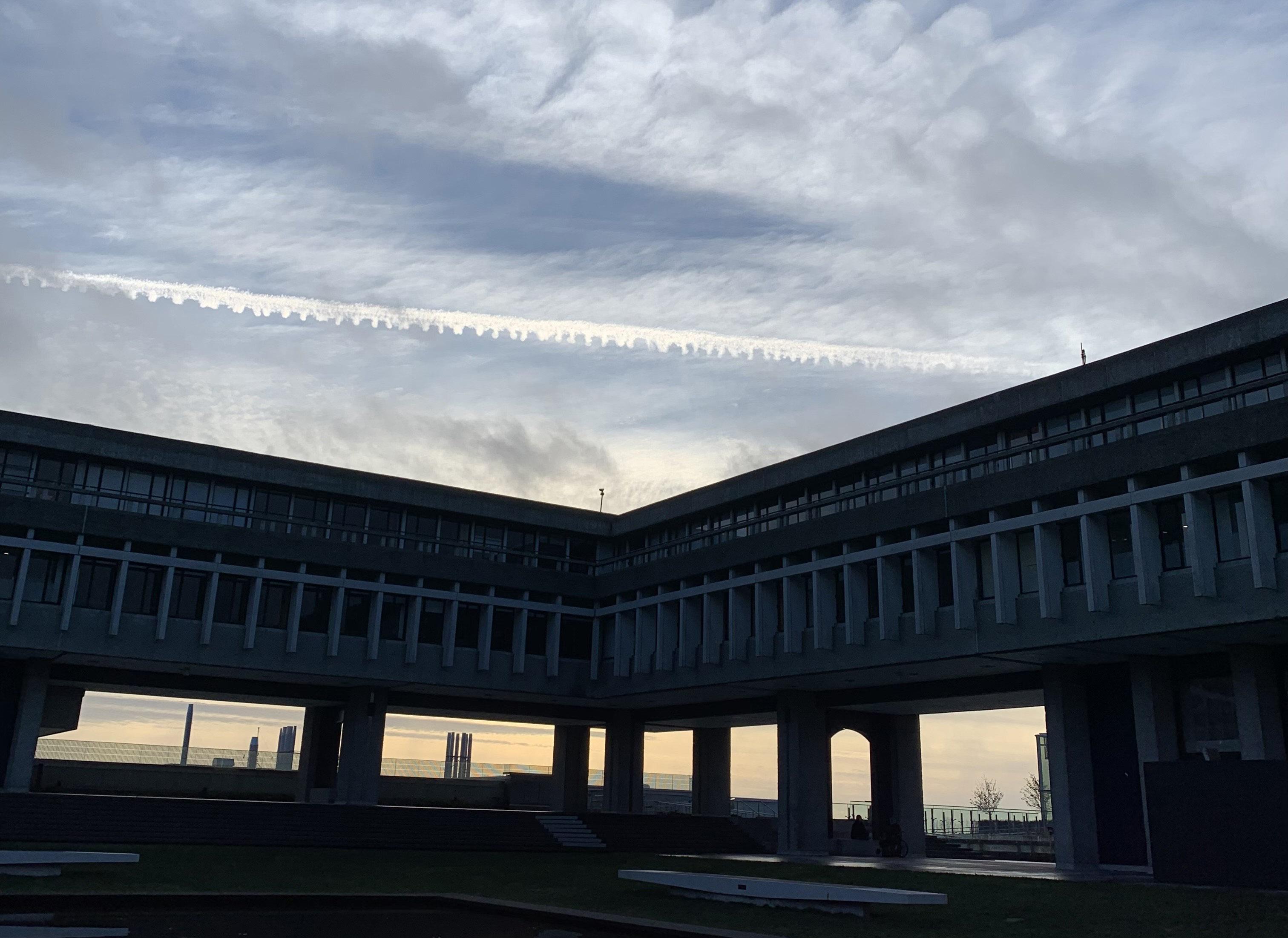
Peak’s first newspapers, it was very interesting to see student expressions adapt through time.
A Magical Time offers more than a description of SFU’s artistic debut, it is a legacy that carries on and shares the importance of its roots — roots that still bear an imprint on students today to engage in education, community and creativity.
From the start, creativity, activism, and experimentation was the heart of SFU’s culture.
Whether you are a student in arts, sciences, or business, the stories in the book are powerful reflections of SFU’s culture that we are part of today. I recommend checking out the book not only to satisfy your curiosity but also to have a better understanding of the place you are graduating from and give meaning to your time at SFU after graduation. In other words, become an alumnus that carries the university’s story with pride.
The official book launch will take place on Tuesday, June 3 at SFU School for the Contemporary Arts. If you are free, drop by and experience this great opportunity to celebrate SFU’s legacy.
The Peak hit the streets to ask SFU students some thought-provoking questions
Mason Mattu Humour Editor
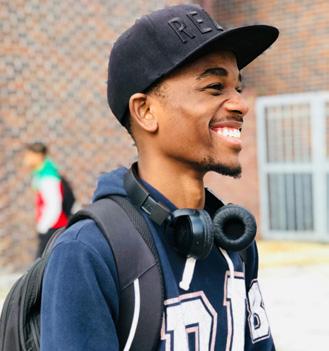
Matt Gordon
First year applied mathematics
“Those folks who write WikiHow articles. Thanks to them, I know how to give someone a hickey. That’s some inspiring and life-changing shit. I’m sure my non-existent girlfriend will love it.”

Katherine Xie
Third year world literature
“Kim Kardashian. She once told the masses to “get your fucking ass up and work,” and I wholeheartedly agree. She’s a self-made billionaire (with a bit of her famous daddy’s help), a fashion icon, and a working-class woman. I betcha Kardashian works 9:00 to 5:00 just so she can feel pity for us underlings . . . Honestly, if hustle culture had a plastic face, it would be 40% hard work, 20% motivation, and 100% Kim Kardashian.”

Christopher Brodzki
Fourth year Communication
“Whoever does SFU media relations work. They deserve a cookie after defending the undefendables.”

Dominik Green
Third year Beedie
“That guy who like invented those like beer sleeves that are designed for like pop drinks. Like, truly inspiring work. That way the like frat party doesn’t like . . . you know . . . stop in lecture!” (takes a sip of “Diet Coke”)

Sally Gord
Second year physics
“Susan Boyle. She made it socially acceptable to peak after your 40s, which gives me a little bit of hope. Too bad I don’t sing.”


Sarah Sorochuk · Peak Associate
Going to bed with a DIY spray tan, Summertime classes. Waking up for an 8:00 a.m., My summertime classes.
I’ve got my backpack on today, Dreaming of a day when I could be away. Anywhere, but here in this lecture hall, I’m listening in, but I’m just dreaming during it all.
Oh, my gawd. I see it in the air, they got the alc-o-hol, The summer parties are for all. But none — for me — I’m stuck alone you see. Nothing changes in my life now.
My friends are partying on the beach with a bonfire, Smokin’ a cigarette or three. All the while, I’m sitting here in this lib-rary. Writing notes on the pages, While my besties are living it up at rages.
I’m living this summertime, summertime sadness, While I’m doing these boring summertime classes. Classes consuming all of me, Instead of my friends saving me. Heeeeeeellllp, please just help me.
I’ve got these summertime, summertime classes, Dying in my summertime, summertime classes. No, nooo no no-ohh. (send help please).

By: Zainab Salam
II have a humongous problem on my hands. And I heard you’re the best at solving those since you’re a Beedie student! I mainly have classes on the Burnaby campus, and parking here is an absolute nightmare. I spend more time searching for a spot than I do in class.
I’ve tried everything: arriving early, bribing friends, and even contemplating teleportation. Nothing works. What’s your expert advice on scoring a parking spot without going into road rage mode?
Sincerely,
Frustrated in the Forest
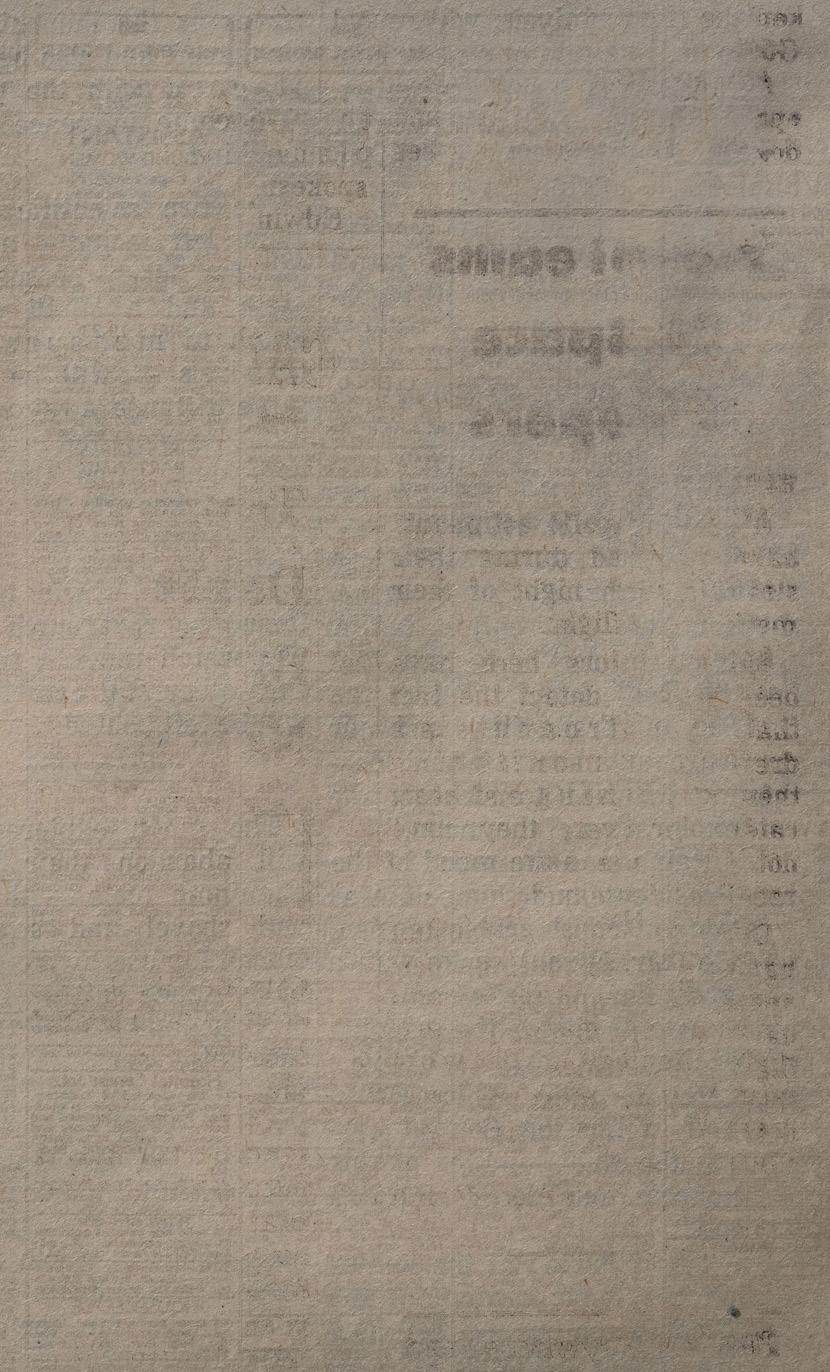
PHOTO: Audrey Safikhani / The Peak
Yo, Frustrated in the Forest,
Ah, parking at SFU Burnaby, the true Hunger Games of higher education. A challenge so legendary, my macroeconomics professor provided extra credit on the syllabus to those who provided proof of proficient parking. But worry not! As the Guy Who Knows It All, I am here to bestow upon you a comprehensive and foolproof strategy that would make even the most seasoned valet weep with envy.
I’m a Beedie Bro, so sit back, relax, and just trust me, bro.
First, avoid arriving early. That’s what everyone expects. Instead, show up precisely 30 seconds before your class starts. This guarantees maximum chaos and will make any spot you find feel like a miracle.
Next, do not circle the lot. That’s a beta move. Instead, park creatively like an alpha. Tree branches in the north lot? Extra shade. Sidewalk? Think of it as elevated parking. Fire lane? Those are just VIP valet spots that the university is hiding from us. And if all else fails, simply park in a random UniverCity parking spot next to a townhouse; it’s not trespassing if you look confident.
And who would I be if I don’t tell you about my homie, the raccoon valet? He can manage your parking needs for as little as twenty cents (he has e-transfer). He usually takes in new clients every Sunday, right by the lower staircase by the Recreation Center. And sure, your car might come back with mysterious scratch marks and smell faintly of pizza, but isn’t that just part of the university experience?
If even one of those flawless tactics fails, it’s time to unleash the secret weapon: the overnight camping method. Set up a small but sturdy tent in your preferred lot. Make sure to decorate to uplift your spirit. I am a big fan of “Grind, Conquer, Park” signs for aesthetic and thematic appeal. I usually set the vibe with my “Vibes Under the Moonlight” playlist, which I linked below. You just need to pay 50 BTC (Bitcoin, baby!) to access this curated glory. It begins with a slowed and reverb version of none other than the hit classic, “Eye of the Tiger.” Make friends with the resident raccoons, and toast to the fact that you’ve ascended beyond the concept of mere studentship, and now you are now a parking pioneer.
The ultimate secret is this: make peace with the fact that parking at Burnaby is less about getting a spot and more about self-discovery. Who are you when all seems lost? Your mother’s disappointment? Or a true alpha male conqueror of concrete jungles?
Finally, remember that true victory is psychological. Don’t just park. Embody chaos. Screech dramatically whenever you see an open spot, even if you have no intention of parking there. Confuse your competitors (those sleazy students who are trying to get to their exams on time!! So selfish of them). Sabotage is just a fancy word for strategy.
Happy hunting,
The Guy Who Knows It All
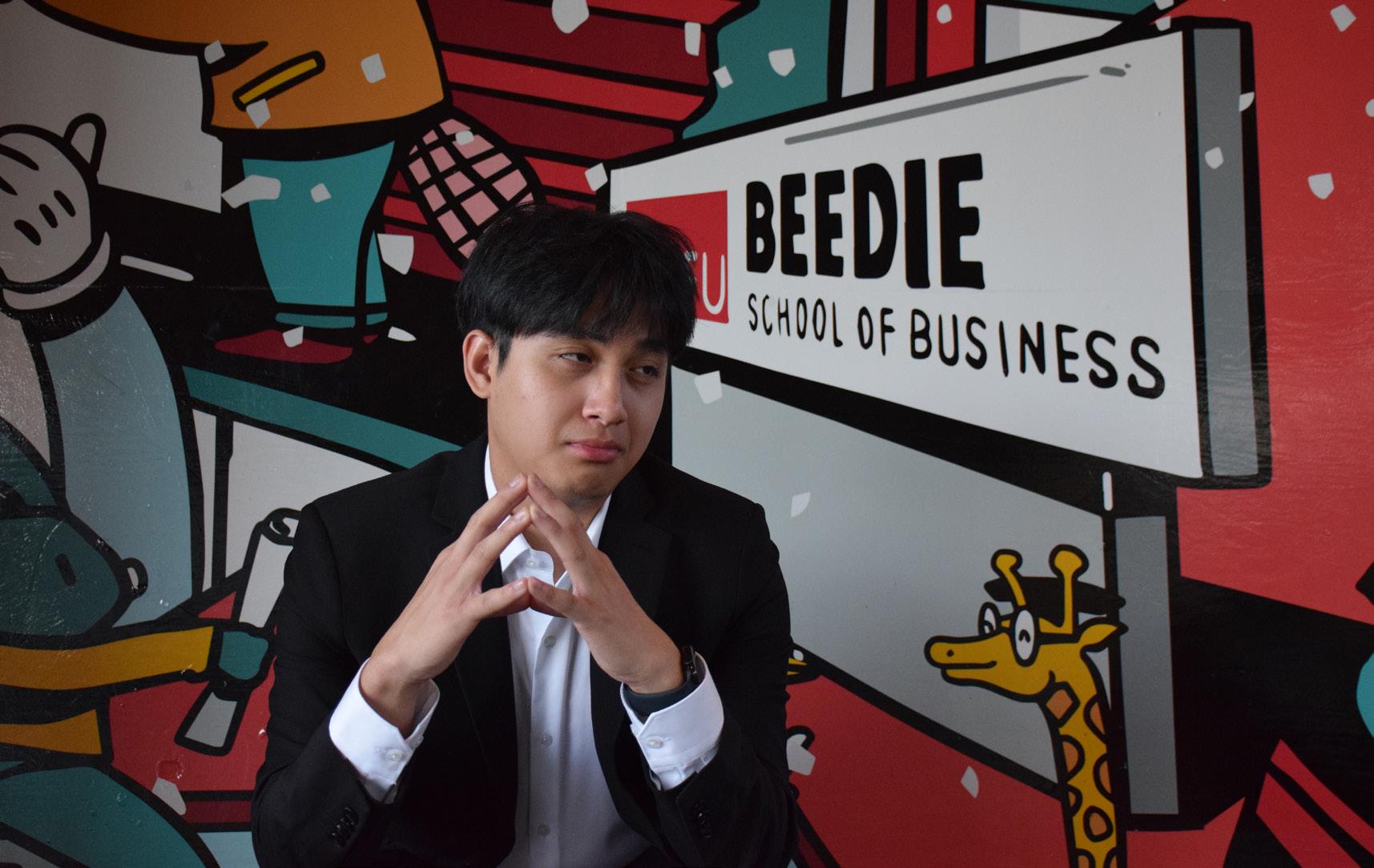
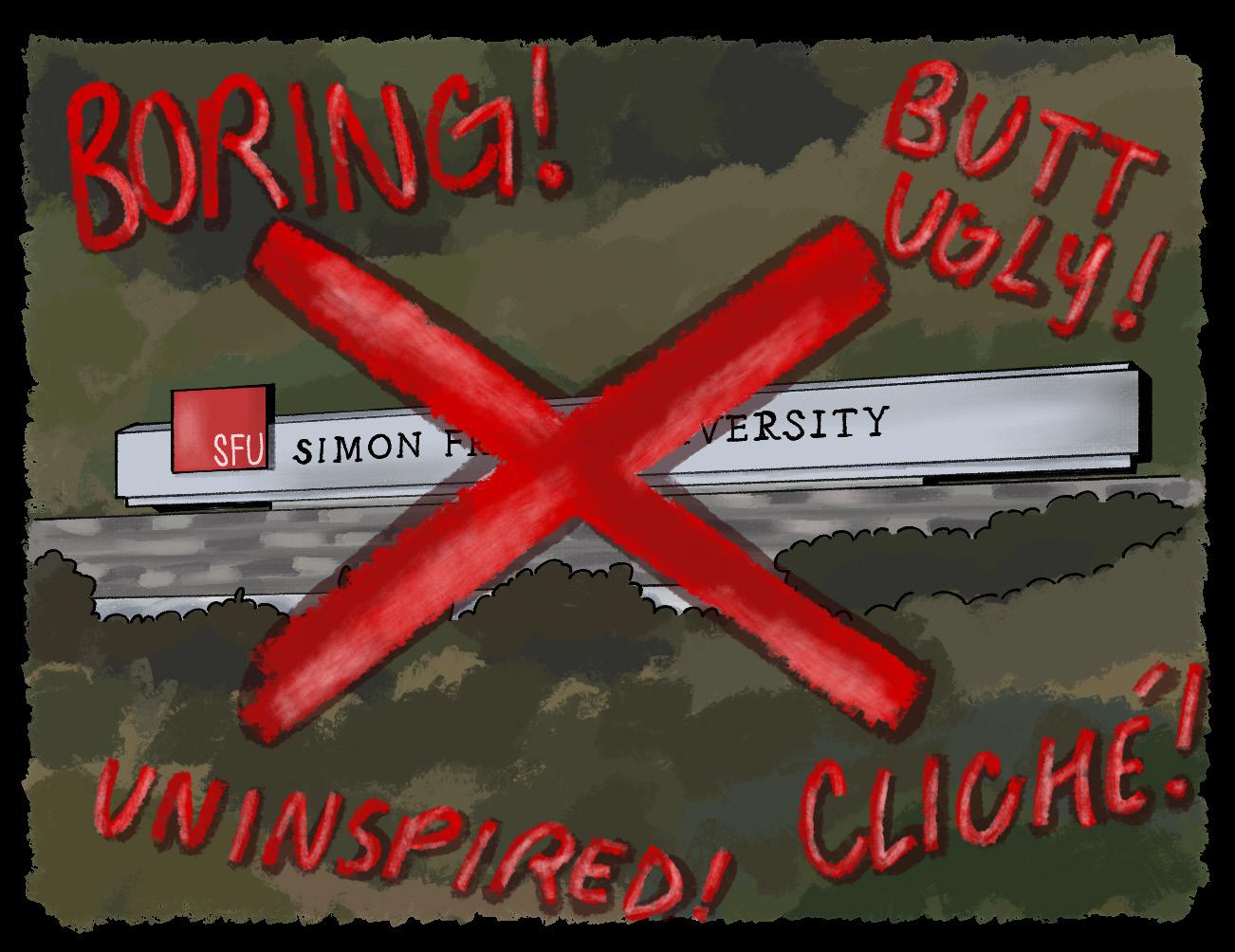
In a shocking yet unsurprising twist, SFU was recently robbed of its soul. No, not our collective conscience! The logo on the SFU welcome sign at the foot of the campus. The beloved red symbol of caffeine dependency (foreshadowing your search for a free parking spot on campus) went missing.
But fret not, dearest students, for the logo has since returned. And yet, in a totally credible Fraser Institute study, 110% of SFU students have now proclaimed the welcome sign “butt ugly.”
Perhaps it’s time for a redesign that better reflects the SFU experience in its full glory. With zero budget, minimal artistic expertise, and a heavy dose of metaphor, enter: our top five visionary contenders for replacing our #boringsign.
1) A giant clock that shows you’re always early (for the next class)
Nothing says “welcome” like a friendly reminder that time is an illusion and your schedule is a self-made prison. This oversized clock isn’t broken — it’s just set to a mystical time zone known only to course schedulers, mountain ghosts, and the R5 bus drivers. Running late again? Don’t worry! According to this tasteful installation, you’re just very early for your next class. It’s not lying, it’s optimism! Even if time is fake, your efforts (and panic) are
Why fix the system when you can redesign the signage?
Ashima Shukla • Postmodernist-in-Residence
very real. So, enjoy this reminder that you’re way ahead of the game (even if not the one you’re currently in).
2) An introvert’s nightmare: an interactive absurdist performance
Bringing Beckett to Burnaby, picture this: an immersive installation that invites you to stand at its centre while four figures walk around you in a repeating but nonsensical pattern. No one makes eye contact. No one leaves. All you hear is the haunting rhythm of footsteps and small talk.
Inspired by Samuel Beckett’s Quad, this piece welcomes you to SFU’s hypersocial yet deeply isolating university life. Are you the main character in a tragicomedy or just heading to the AQ? Come find out!
And yes — the performance never ends.
3) A “not UBC” sign
Minimalist. Iconic. Proudly contrarian. Perfect for when visitors need clarity and students need closure. The sign isn’t competitive — it’s just setting the record straight. No, we don’t have a nude beach or heritage ivy.
But we do have racoons. And fog. And don’t you dare forget our brutalist concrete that builds character (and strong calves).
4) A goSFU MySchedule simulation that rearranges itself when you look away
This cursed display shows you a perfect schedule as you drive up the mountain — until you blink. Then, you’ve suddenly got two overlapping seminars, a lab in Surrey, and a 3:00 a.m. tutorial for another faculty that you cannot drop. Bonus points if you catch it glitch, showing a waitlisted course from 2020. Why? Because chaos is free, unlike your tuition.
5) A giant red splotch of red paint
This bold and provocative piece of abstract art is titled, “The Cost of Knowledge: A Generous Donation.” Whether it’s the emotional toll of a degree with job prospects TBD or the lack of funding no one wants to talk about, this vivid splash of red fosters the kind of critical thinking the administration just loves. English students can debate its meaning, engineering students calculate the structural integrity of the metaphor. Either way, it’s Rothko meets capitalism.
In the end, maybe our SFU logo isn’t as much a welcome as an ask. Like looking into a mirror, it offers a moment of introspection to consider, “Are you sure? Are you ready?” As the mountain swallows your cell signal, the wind gently murmurs a reply, “No. But you’re here anyway.” Because that is the SFU spirit — uncertain but committed. And hauntingly self-aware.



